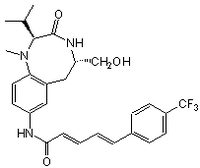All AbMole products are for research use only, cannot be used for human consumption.

TPPB has been demonstrated to activate PKC in this cell line, this effect was seen with TPPB doses in the order of 10–1,000 × g greater than those used for bryostatin-1 in the current studies. Therefore, when comparing bryostatin-1 and TPPB, a recognized APP modulator, bryostatin-1 was found to potently activate PKC-ε translocation in SH-SY5Y cells at 10−8, 10−9, and 10−10 (at 3 h).
| Cell Experiment | |
|---|---|
| Cell lines | SH-SY5Y neuroblastoma cells |
| Preparation method | Cells were grown to confluency in 10 % serum-supplemented medium. Dilutions of bryostatin-1 or TPPB were added to serum-free culture medium at various concentrations and treatments maintained for 3 h, except in time course experiments where several time points up to 24 h were taken. Pilot studies showed no change in SH-SY5Y appearance, attachment, or cell density for at least 24 h under these conditions. |
| Concentrations | 10 μM |
| Incubation time | 24 h |
| Animal Experiment | |
|---|---|
| Animal models | |
| Formulation | |
| Dosages | |
| Administration | |
| Molecular Weight | 501.54 |
| Formula | C27H30F3N3O3 |
| CAS Number | 497259-23-1 |
| Form | Solid |
| Solubility (25°C) | DMSO ≥ 100 mg/mL |
| Storage |
Powder -20°C 3 years ; 4°C 2 years In solvent -80°C 6 months ; -20°C 1 month |
| Related PKC Products |
|---|
| Sapintoxin D
Sapintoxin D is a fluorescent phorbol ester that can be used to study the activation of protein kinase C (PKC). |
| Bryostatin 3
Bryostatin 3, a macrocyclic lactone, is a protein kinase C activator, with a Ki of 2.75 nM. |
| Ruboxistaurin mesylate
Ruboxistaurin (LY333531) mesylate is an orally active, selective and ATP competitive PKCβ inhibitor with IC50 values of 4.7 and 5.9 nM for PKCβI and PKCβII, respectively. |
| PKC β pseudosubstrate
PKC β pseudosubstrate is a selective cell-permeable inhibitor of PKC. |
| Protein Kinase C (19-31)
Protein Kinase C (19-31), a peptide inhibitor of protein kinase C (PKC), is used as protein kinase C substrate peptide for testing the protein kinase C activity. |
All AbMole products are for research use only, cannot be used for human consumption or veterinary use. We do not provide products or services to individuals. Please comply with the intended use and do not use AbMole products for any other purpose.


Products are for research use only. Not for human use. We do not sell to patients.
© Copyright 2010-2024 AbMole BioScience. All Rights Reserved.
